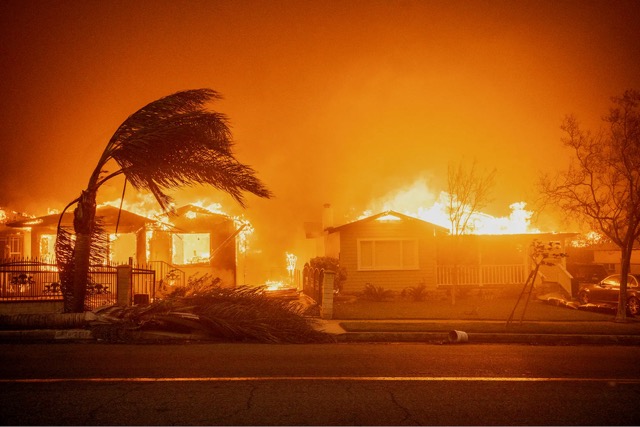Insurance Premiums
BY LEVI SUMAGAYSAY, CalMatters
The deadly and destructive fires in Los Angeles — which some say could be the costliest in the state’s history — will further strain the insurance market and worsen the financial position of California’s insurer of last resort.
Data about Pacific Palisades, the devastated LA neighborhood whose residents include movie stars and directors, help illustrate the insurance problems plaguing the state. An estimated 1 in 5 homes in the upscale neighborhood were covered by the insurer, known as the FAIR Plan.
Property owners in California have increasingly been turning to the plan, a pool of insurers required by state law to sell fire policies to consumers who can’t find regular insurance elsewhere. That’s because, for the past few years, insurance companies have been canceling policies or refusing to write new ones in California, citing rising risk of wildfires. As a result, the FAIR Plan’s number of homeowner policies grew to more than 451,000 as of September 2024, an increase of 123% over the past three years.
Last year, State Farm decided not to renew tens of thousands of policies in the state, including about 1,600 in Pacific Palisades. As of September, there were 1,430 residential FAIR Plan policies in the enclave’s 90272 ZIP code, an 85% increase from the previous year, according to the plan’s latest data.
Elsewhere in Los Angeles, some cities and neighborhoods with spiking FAIR Plan use have either been evacuated or are near the fires. They include the 90402 ZIP code in Santa Monica, where FAIR Plan policies have increased 128% year over year.
This massively complicates things.” – STEPHEN COLLIER, PROFESSOR OF CITY AND REGIONAL PLANNING AT UC BERKELEY
Now, after at least five people have died and more than 2,000 structures have been destroyed in the LA area, and as those who have lost their homes begin to submit claims with their insurance companies, there’s a big question mark around the state’s plan to try to ensure insurance availability. A plan touted by Insurance Commissioner Ricardo Lara as a way to get insurance companies to write policies in the state again just became effective at the beginning of the year.
The so-called sustainable insurance strategy includes having the state speed reviews of rate hike requests from insurance companies and allow insurers to use catastrophe models when setting their premiums. Insurers would also be able to adjust for the cost of their own financial backstop, known as reinsurance. The concessions mean insurers will raise premiums for the state’s property owners but in exchange must write or maintain a certain number of policies in high-risk areas.
“There’s no doubt that this massively complicates things,” said Stephen Collier, professor of city and regional planning at UC Berkeley whose research focuses on insurance, climate change and urban planning. “It couldn’t be at a worse possible time.”
Lara also told CalMatters today that “of course this is going to complicate an already complicated market.”
But the commissioner said he has been in touch with insurance companies in the past couple of days: “The reforms are in place now, the (insurers’) commitments are in place now. As far as my conversations as recently as last night, those still stand and move forward.”
In addition, the FAIR Plan, the insurer for many of those affected by the current blazes, will likely have to pay claims for tens of billions of dollars in damages.
Collier said that massive potential liability could make insurers “think twice” about whether they want to keep writing policies in the state. “Having all this risk transferred to the FAIR Plan doesn’t get insurers off the hook if they’re still writing in the California market,” he said. That’s because insurers in the state are on the hook to pay into the plan when it can’t cover all its claims.
Pacific Palisades is on the FAIR Plan’s list of top five areas in Southern California with the highest wildfire exposure, or potential insurance payout — at nearly $6 billion. Other neighborhoods in the top five, in order, are all in San Bernardino County east of Los Angeles: Lake Arrowhead ($9.14 billion), Crestline ($7.81 billion), Big Bear City ($7.1 billion) and Big Bear Lake ($6.73 billion).
The FAIR Plan’s total exposure statewide as of September, the end of its fiscal year, is $458 billion.
Victoria Roach, president of the FAIR Plan, has over the past couple of years raised concerns about the plan’s finances as its number of policies grows. For example, in testimony before the California Assembly Insurance Oversight Committee last year, she said “as those numbers climb, our financial stability comes more in question.”
Roach also said at that same hearing that the FAIR Plan was “one event away from a large assessment.” An assessment is when the plan does not have enough reserves to pay claims and must turn to its member insurers to ask them to contribute to doing so. The FAIR Plan will impose a surcharge on insurance companies based on their market share in the state.
Roach was unavailable for an interview on Wednesday, but Hilary McLean, a spokesperson for the FAIR Plan, said: “We are aware of misinformation being posted online regarding the FAIR Plan’s ability to pay claims. It is too early to provide loss estimates as claims are just beginning to be submitted and processed.”
McLean added that the plan has “payment mechanisms in place, including reinsurance, to ensure all covered claims are paid.”
Meanwhile, the commissioner’s plan to right-size the insurance market had barely gotten off the ground when the LA fires started on Tuesday, having launched less than a week before.
Denni Ritter, vice president at American Property Casualty Insurance Association, said the state’s “horrific fires underscore the importance of this work” to reform California insurance rules. “We remain committed to working with California’s leaders to restore the health of our insurance market so that Californians can access the coverage they need,” she added.
Lara pointed out that his reforms include an agreement with the FAIR Plan. This provides the Insurance Department with “data to track any solvency issues” with the plan and allows insurers to proactively ask for premium increases for future catastrophic claims, which Lara said “creates another set of certainty” for insurers that should keep them in the state’s market.
The message from Lara and some other experts is clear: Insurance customers are facing possibly drastically higher premiums in the short run, with the hopes that it will all lead to stabilization of the market in the long run.
Lara’s predecessor as state insurance commissioner, Dave Jones, said “with the LA fires, once they have a handle on their losses, insurers will seek even higher rate increases.”
Said David Russell, professor of insurance at Cal State University Northridge: “These fires are validating the rate increases and (insurance) industry pressure over the last 18 to 24 months.” He added that “ultimately we need those rate requests to be granted,” and quickly.
Forecasting company AccuWeather’s preliminary estimate of the economic toll from this set of fires on Wednesday was $52 billion to $57 billion — and they are continuing to burn. Dan DePodwin, senior director of forecasting operations at AccuWeather, said that includes an estimate of the insured losses, which may account for 25% to 50% of the total, though it is too early to know for sure. The estimate also takes into account possible future economic losses, including to people’s health, businesses and the infrastructure around the major urban area. This afternoon, AccuWeather raised its estimate to $135 billion to $150 billion.
“It could be the costliest set of fires in modern California, if not U.S., history,” he said.

For More Fire Season News Visit www.zapinin.com/fire-season

